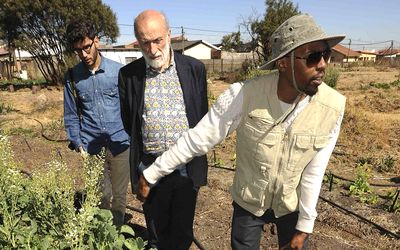MORE than 100,000 years ago, just south of Mossel Bay, people sat down to enjoy what has become a fairly rare feast — oysters.
Mitochondrial DNA research has shown that all humans alive today descend from a small population that lived between 150,000 and 200,000 years ago, and archaeological research has shown that at least some of those people lived in Mossel Bay, say researchers at Pinnacle Point.
While the South African chapter of the international Slow Food Movement has claimed the Cape rock oyster as the culinary hero of this ancient story, Dr Antonieta Jerardino, of the University of SA’s anthropology and archaeology department, says they have singled out the wrong species of bivalve. The delicacy in question is instead not one, but several species of shellfish — limpets and a species of large turban snail known as "alikreukel".
"Oysters were hardly ever collected in those days, but did get harvested in modest numbers only later during the last two millennia," she says.
It looks, then, like the South African Slow Food Movement has even more work to do. It is busily populating an "Ark of Taste" for SA — a catalogue of indigenous and culturally significant foods, recipes, and food production processes. SA’s list will join similar lists in the 170-odd countries across the world where Slow Food Movement chapters exist. It’s possible that both oyster species deserve an entry.
Italian Carlo Petrini started the international movement in 1989 with the release of a Slow Food Manifesto that called for "good, clean, and fair" food for everyone everywhere — food that is nutritious, propagated without noxious chemicals, and fair in price, for farmer and consumer.
In SA work on the Ark of Taste started fairly recently.
There are 40-odd entries, and the South African Slow Food Movement’s members are busily adding to it.
"We are all volunteers. It’s our passion that drives us to do this," says Brian Dick, chairman of the Johannesburg Slow Food Movement.
It was passion that drove Petrini too. For him, 1986 was a pivotal year: US multinational McDonald’s opened a branch in Rome’s Piazza di Spagna. Also, 19 people died and hundreds were poisoned by cheap wine diluted with methanol. While France had seen farmers protest against McDonald’s entry to that market, Petrini chose a different tack. Instead of fighting the multinationals, he decided to work to build awareness of the rich cultural heritage that lay in food traditions, reasoning that if people knew what they stood to lose they would work to save it.
...
THE wine debacle played into his hands. Exports of Italian wine dropped by more than a third because of it, making clear to Italians the importance of honouring tradition as a way of protecting their economy, and maintaining their formidable culinary reputation.
Thirty years later Petrini is special ambassador of the UN Food and Agriculture Organisation Zero Hunger for Europe campaign, which wants to eradicate global hunger by 2030.
Petrini visited SA this week. He says he came because he heard that the South African Slow Food community was compiling an Ark of Taste, and that it was trying to ascertain how many community gardens there were in SA.
"There are 10,000 food gardens in SA, I am convinced of it," says farmer Geoff Green, who is working with the South African Slow Food Movement to come up with a tally of SA’s food gardens. In Soweto, Petrini met smallholder Phila Cele, whose special brand of chilli is on its way to a spot in the Ark of Taste.
"We have never had such recognition before, particularly on a global stage," Cele says. "Our customers know we produce a top-class product, but this honour from Slow Food has been amazing."
Petrini says: "We have to stand alongside the farmers. The principal job we have to do around the world is to defend local products and cuisine."
He tells the story of travelling in northern Italy, near his birthplace, Bra, and settling down at a restaurant licking his lips at the idea of the delicious local pepperoni. What appeared on his plate was a pale cousin, and Petrini learned to his horror that the pepperoni-producing local farmers had stopped production. Instead they had planted tulips that were sent to Holland, and the pepperoni now used in the restaurant came from Holland. "We’re mad," he says. "From that moment I started to defend biodiversity. This is not archaeology or curatorship. This is modernity, the use of technology to protect heritage. This heritage is value and we are pointing to it with the Ark of Taste," he says.
...
READ THIS: WATCH: Why aviation industry struggles in Africa
SA HAS a lot of work to do, Dick says. The movement has promised itself it will add 30 more Ark of Taste entries by September. It has a list of 100 it has to catalogue. To enter the Ark a food, species, recipe, or process has to be researched and nominated to a committee in Italy.
"A lot are tied to cultural tradition," Dick says. "It’s not just writing about the food; it’s tying it back to the culture. In the move from rural to urban areas there is a slight loss of cultural identity."
SA is fast urbanising. A 2013 government report predicts that by 2050 nearly 80% of SA’s population will be living in an urban area.
The Ark of Taste is not aimed at being "biologically pure", Dick says. "It’s more about the culture, although the vast majority of the entries are indigenous to a region. Like the chillies of Soweto, these things morph to become specific to an area or people."

Slow Food Italy’s Francesco Anastasi, left, and Slow Food founder Carlo Petrini visit the garden of Soweto smallholder Phila Cele to sample his special brand of chilli. Picture: MALCOLM DRUMMOND
MORE than 100,000 years ago, just south of Mossel Bay, people sat down to enjoy what has become a fairly rare feast — oysters.
Mitochondrial DNA research has shown that all humans alive today descend from a small population that lived between 150,000 and 200,000 years ago, and archaeological research has shown that at least some of those people lived in Mossel Bay, say researchers at Pinnacle Point.
While the South African chapter of the international Slow Food Movement has claimed the Cape rock oyster as the culinary hero of this ancient story, Dr Antonieta Jerardino, of the University of SA’s anthropology and archaeology department, says they have singled out the wrong species of bivalve. The delicacy in question is instead not one, but several species of shellfish — limpets and a species of large turban snail known as "alikreukel".
"Oysters were hardly ever collected in those days, but did get harvested in modest numbers only later during the last two millennia," she says.
It looks, then, like the South African Slow Food Movement has even more work to do. It is busily populating an "Ark of Taste" for SA — a catalogue of indigenous and culturally significant foods, recipes, and food production processes. SA’s list will join similar lists in the 170-odd countries across the world where Slow Food Movement chapters exist. It’s possible that both oyster species deserve an entry.
Italian Carlo Petrini started the international movement in 1989 with the release of a Slow Food Manifesto that called for "good, clean, and fair" food for everyone everywhere — food that is nutritious, propagated without noxious chemicals, and fair in price, for farmer and consumer.
In SA work on the Ark of Taste started fairly recently.
There are 40-odd entries, and the South African Slow Food Movement’s members are busily adding to it.
"We are all volunteers. It’s our passion that drives us to do this," says Brian Dick, chairman of the Johannesburg Slow Food Movement.
It was passion that drove Petrini too. For him, 1986 was a pivotal year: US multinational McDonald’s opened a branch in Rome’s Piazza di Spagna. Also, 19 people died and hundreds were poisoned by cheap wine diluted with methanol. While France had seen farmers protest against McDonald’s entry to that market, Petrini chose a different tack. Instead of fighting the multinationals, he decided to work to build awareness of the rich cultural heritage that lay in food traditions, reasoning that if people knew what they stood to lose they would work to save it.
...
THE wine debacle played into his hands. Exports of Italian wine dropped by more than a third because of it, making clear to Italians the importance of honouring tradition as a way of protecting their economy, and maintaining their formidable culinary reputation.
Thirty years later Petrini is special ambassador of the UN Food and Agriculture Organisation Zero Hunger for Europe campaign, which wants to eradicate global hunger by 2030.
Petrini visited SA this week. He says he came because he heard that the South African Slow Food community was compiling an Ark of Taste, and that it was trying to ascertain how many community gardens there were in SA.
"There are 10,000 food gardens in SA, I am convinced of it," says farmer Geoff Green, who is working with the South African Slow Food Movement to come up with a tally of SA’s food gardens. In Soweto, Petrini met smallholder Phila Cele, whose special brand of chilli is on its way to a spot in the Ark of Taste.
"We have never had such recognition before, particularly on a global stage," Cele says. "Our customers know we produce a top-class product, but this honour from Slow Food has been amazing."
Petrini says: "We have to stand alongside the farmers. The principal job we have to do around the world is to defend local products and cuisine."
He tells the story of travelling in northern Italy, near his birthplace, Bra, and settling down at a restaurant licking his lips at the idea of the delicious local pepperoni. What appeared on his plate was a pale cousin, and Petrini learned to his horror that the pepperoni-producing local farmers had stopped production. Instead they had planted tulips that were sent to Holland, and the pepperoni now used in the restaurant came from Holland. "We’re mad," he says. "From that moment I started to defend biodiversity. This is not archaeology or curatorship. This is modernity, the use of technology to protect heritage. This heritage is value and we are pointing to it with the Ark of Taste," he says.
...
READ THIS: WATCH: Why aviation industry struggles in Africa
SA HAS a lot of work to do, Dick says. The movement has promised itself it will add 30 more Ark of Taste entries by September. It has a list of 100 it has to catalogue. To enter the Ark a food, species, recipe, or process has to be researched and nominated to a committee in Italy.
"A lot are tied to cultural tradition," Dick says. "It’s not just writing about the food; it’s tying it back to the culture. In the move from rural to urban areas there is a slight loss of cultural identity."
SA is fast urbanising. A 2013 government report predicts that by 2050 nearly 80% of SA’s population will be living in an urban area.
The Ark of Taste is not aimed at being "biologically pure", Dick says. "It’s more about the culture, although the vast majority of the entries are indigenous to a region. Like the chillies of Soweto, these things morph to become specific to an area or people."



















